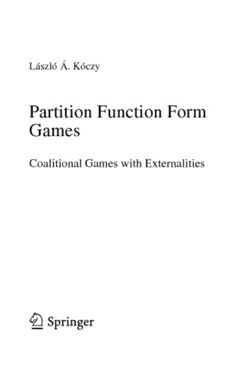Table Of ContentLászló Á. Kóczy
Partition Function Form
Games
Coalitional Games with Externalities
LászlóÁ.Kóczy
InstituteofEconomics
CentreforEconomicsandRegionalStudies
HungarianAcademyofSciences
Budapest
Hungary
and
KeletiFacultyofBusinessandManagement
ÓbudaUniversity
Budapest
Hungary
ISSN0924-6126
Theory and DecisionLibraryC
ISBN978-3-319-69840-3 ISBN978-3-319-69841-0(eBook)
https://doi.org/10.1007/978-3-319-69841-0
LibraryofCongressControlNumber:2018933585
©SpringerInternationalPublishingAG2018
Preface
I became interested in partition function form games early in my academic career
and, by now, have a few publications on the topic. Such games are not new but it
wasoftendifficulttopresentthesepapersatconferencesastheaudienceknewlittle
about partition function form games. I often wished I could direct the interested
researchertoabasictextforaquickintroduction.ItwasLarsEhlerswhosuggested
thatperhapsIshouldwriteabookaboutthem.Theoriginalplanwaslessambitious
but,goingdeeperintheliterature,manynewconnections,hiddenresults,andpapers
havebeenuncovered.Itwasalsodifficulttokeepupwiththelatestadditionstothe
fieldwithsomanynewpaperspublishedinthelastfewyears.Completingthisbook
tookseveralyearsanditwouldnothavebeenpossiblewithoutthepatienceofmy
employer, the help of my colleagues and my family. I am grateful to the Institute
of Economics, Centre for Economic and Regional Sciences, Hungarian Academy
of Sciences and O´buda University for letting me devote time to this project and
to my game theory friends and colleagues for tolerating my anti-social behaviour
regardingseminarsandrefereeingrequests.IespeciallythankHansPeters,Miklo´s
Pinte´randA´gnesCsehfortheircommentsandAttilaNa´sforcarefullyreadingthe
manuscript.Last,butnotleast,Ithankmyfamily:mywife,AnitaVizyandchildren
Lacko´,Mici,Palko´ andIstifortheirloveandendlesspatience.
Budapest,Hungary La´szlo´ A´.Ko´czy
June2017
Contents
ListofSymbols .................................................... xiii
PartI Foundations
1 Purposeofthebook ............................................ 3
1.1 Introduction ............................................... 3
1.2 AboutthisBook ........................................... 5
References..................................................... 6
2 TerminologyandNotation ...................................... 7
2.1 Introduction ............................................... 7
2.2 Numbers.................................................. 8
2.3 Sets ...................................................... 9
2.3.1 Partitions ........................................... 9
2.3.2 Permutations........................................ 14
2.4 VectorsandMatrices........................................ 15
2.5 GraphsandNetworks ....................................... 16
2.5.1 Connectivity ........................................ 16
2.5.2 Trees .............................................. 17
References..................................................... 17
3 Preliminaries .................................................. 19
3.1 Introduction ............................................... 19
3.2 NormalFormGames........................................ 20
3.3 ExtensiveFormGames...................................... 22
3.4 CharacteristicFunctionFormGames .......................... 25
3.4.1 Properties .......................................... 27
3.4.2 SolutionConcepts:Stability ........................... 29
3.4.3 SolutionConcepts:Fairness ........................... 37
3.4.4 GamesoverNetworks ................................ 41
3.5 PartitionFunctionFormGames............................... 43
3.5.1 ExternalitiesinPartitionFunctionFormGames........... 45
3.5.2 PropertiesofPartitionFunctionFormGames............. 47
3.5.3 ModifiedPartitionFunctionFormGames ................ 50
3.6 DynamicCooperativeGames................................. 53
References..................................................... 55
PartII Stability
4 Dominance .................................................... 63
4.1 Introduction ............................................... 63
4.2 DirectDominanceModels ................................... 64
4.3 CoalitionFormationRules ................................... 66
4.4 Farsightedness ............................................. 67
References..................................................... 68
5 TheCore...................................................... 71
5.1 Introduction ............................................... 71
5.2 Thea-Core ............................................... 72
5.3 Thew-Core ............................................... 74
5.4 PartialAgreementEquilibriumandthes-Core .................. 76
5.4.1 PartialAgreementEquilibriumandtheg-Core............ 77
5.4.2 Thes-Core.......................................... 78
5.4.3 TheDisintegrationRule............................... 80
5.4.4 Thef-Core ......................................... 80
5.5 Themergeorm-Core ....................................... 80
5.6 TheProjectionRuleandthed-core............................ 81
5.7 TheRationalExpectationsCore .............................. 82
5.8 RecursiveCores............................................ 83
5.8.1 Ther-Theory........................................ 84
5.8.2 TheRecursiveCore .................................. 87
5.9 AnAxiomaticComparison................................... 99
5.9.1 Axioms ............................................101
5.9.2 Characterisations ....................................102
5.10 Conclusion................................................103
References.....................................................104
6 ImplementationoftheCore .....................................107
6.1 Introduction ...............................................107
6.2 SimultaneousAnnouncementModels..........................109
6.3 AlternatingOffersBargainingModel ..........................110
6.4 SequentialCoalitionFormationwithFixedPayoffDivision .......112
6.4.1 StationaryEquilibriumCoalitionStructures ..............112
6.4.2 SymmetricPartitionFunctionFormGames ..............114
6.5 SequentialCoalitionFormationinTotallyBalancedGames .......116
6.5.1 AContinuous-TimeBargainingModel ..................117
6.5.2 AnOrder-IndependentEquilibriumCoalitionStructures....119
6.6 ImplementationinGeneralPartitionFunctionFormGames .......122
6.6.1 ATwo-StageCoalitionFormationGame.................123
6.6.2 ASequentialCoalitionFormationModel ................125
6.7 Conclusion................................................137
6.A Appendix .................................................138
6.A.1 TheCoreoftheGameinExample6.21..................138
References.....................................................140
7 Otherstabilityconcepts.........................................143
7.1 Introduction ...............................................143
7.2 TheStableSet .............................................143
7.2.1 Introduction.........................................143
7.3 EquilibriumBindingAgreements .............................145
7.3.1 StrategicSetting .....................................146
7.3.2 PartitionFunctionSetting .............................148
7.3.3 Extensions..........................................148
7.4 Conclusion................................................149
References.....................................................149
PartIII Fairness
8 Axioms .......................................................153
8.1 Introduction ...............................................153
8.2 CommonAxioms ..........................................154
8.2.1 Efficiency ..........................................154
8.2.2 Anonymity .........................................155
8.2.3 Symmetry ..........................................156
8.2.4 StandardProperty....................................157
8.3 CarriersandNullPlayers ....................................157
8.3.1 CarrierAxiom.......................................157
8.3.2 Oligarchy...........................................158
8.3.3 NullPlayers.........................................159
8.3.4 DummyPlayers .....................................163
8.4 Additivity,LinearityandTransfer .............................164
8.5 MarginalityandMonotonicity................................165
8.6 ExternalAxioms ...........................................167
8.7 Conclusion................................................170
References.....................................................170
9 TheShapley-value..............................................173
9.1 Introduction ...............................................173
9.2 ClassicalAdditivity-BasedAxiomatisations ....................174
9.2.1 Anonymity,CarrierandAdditivity......................174
9.3 NullPlayerPropertyVariations...............................175
9.3.1 NullPlayerProperty..................................176
9.3.2 StrongNullPlayerProperty ...........................176
9.3.3 Steady-MarginalityNullPlayerProperty.................177
9.3.4 WeakNullPlayerPropertyandMarginality ..............179
9.4 Marginality-BasedAxiomatisations ...........................181
9.5 AveragingMethods.........................................182
9.5.1 TheAverageApproach ...............................182
9.5.2 NullPlayera ........................................183
9.6 AxiomatisationwithoutMarginalityorNullPlayerProperty.......185
9.7 GeneralisationtoGamesthatareNotFullyCohesive.............186
9.8 Potential ..................................................186
9.8.1 MarginalityandPotential .............................187
9.8.2 ExtendingPotentialtoPartitionFunctionFormGames.....187
9.8.3 RestrictionOperators.................................189
9.8.4 Consistency.........................................192
9.9 Implementation:AnEfficientMulti-BiddingProcedure...........194
9.10 Calculations ...............................................197
9.11 Conclusion................................................198
References.....................................................199
10 Othervalues...................................................201
10.1 Introduction ...............................................201
10.2 TheBanzhaf-value .........................................202
10.2.1 SimpleGames.......................................202
10.2.2 PowerMeasures .....................................203
10.2.3 Extensions..........................................204
10.2.4 TheAverageApproach ...............................209
10.2.5 AnOrdinalApproach.................................211
10.3 TheConsensusValue .......................................212
10.3.1 Definition ..........................................212
10.3.2 Characterisation .....................................213
10.4 CoalitionFormationValues ..................................214
10.4.1 Model..............................................214
10.4.2 Values .............................................215
10.5 ExternalitiesinNetworks....................................216
10.5.1 AGeneralisedShapley-value ..........................216
10.5.2 ThePositionValue ...................................218
10.6 Conclusion................................................219
References.....................................................220
PartIV Applications
11 OligopolyModels ..............................................225
11.1 Introduction ...............................................225
11.2 CoalitionFormationinCournotOligopolies ....................226
11.2.1 WhydoFirmsMerge?................................226
11.2.2 MultipleMergers ....................................227
11.2.3 TheFormalModel ...................................228
11.3 SymmetricCournotMergerSystem ...........................231
11.3.1 ADiscretePartitionFunctionModel ....................231
11.3.2 TheStabilityoftheMonopoly .........................232
11.4 MergerswithAntitrustRegulation ............................234
11.5 MergersinInternationalOligopolies...........................235
References.....................................................236
12 EnvironmentalApplications.....................................239
12.1 Introduction ...............................................239
12.2 InternationalEnvironmentalAgreements.......................240
12.3 TragedyoftheCommonsinaFishingLake.....................244
12.3.1 Theory .............................................244
12.3.2 Simulations .........................................247
12.4 StraddlingStockFisheries ...................................249
12.4.1 Bioeconomicmodel ..................................250
12.4.2 Partitionfunction ....................................250
12.5 SharingaRiver ............................................253
12.5.1 ThePractice ........................................254
12.5.2 AFormalModel.....................................255
12.5.3 DownstreamIncrementalDistribution ...................256
12.5.4 UpstreamIncrementalDistribution .....................258
12.5.5 TheWeightedHierarchicalDistribution .................258
12.5.6 SatiableAgents......................................261
12.5.7 Conclusion .........................................265
References.....................................................266
13 FemtocellNetworks ............................................269
13.1 Introduction ...............................................269
13.2 JointFrequencyScheduling..................................270
13.2.1 TheModel..........................................271
13.2.2 Simulations .........................................274
13.2.3 InterferencewithMacrocellUserEquipment .............275
13.3 InterferenceAlignment......................................276
13.3.1 TheModel..........................................276
13.3.2 Simulations .........................................278
References.....................................................278
14 FurtherApplications ...........................................281
14.1 Introducion................................................281
14.2 GamesoverUtilityNetworks.................................282
14.2.1 TrafficRouting ......................................282
14.2.2 ElectricalPowerTransmissionNetworks ................283
14.3 MatchingwithExternalities..................................284
14.4 FreeTradeAgreementsandCustomsUnions ...................285
References.....................................................286
References.........................................................289
Index .............................................................303
Symbols
complexconjugate,page8
(cid:1)
differencebetweenapartitionandaset,page14
n
differencebetweenpartitions,page14
n
setdifference,page9
n
elementofasetrelation,page9
22S powersetofS,page9
accessibility,page54
!
sequentialdomination,page97
!
inductionrelationbetweenaprocessandascenario,page215
!
strictsubsetrelation,page9
(cid:26)
subsetrelation,page9
(cid:18)
finestcommoncoarsening,page12
_
maximumoperator,page165
_
coarsestcommonrefinement,page12
^
minimumoperator,page165
^
absolutevalue,page8
j(cid:1)j
partiton partitionsize,page10
jh ij
set setcardinality,page9
jh ij
[ set ] partitionintosingletons,page10
h i
upperintegerpart,page8
d(cid:1)e
partition minimalpartitionsize,page10
bh ic
integerpart,page8
b(cid:1)c
() positivepart,page8
(cid:1) +
domd d-domination,page66
dom dominancerelation,page31
domd d-dominationviaM,page66
M
dom dominancerelationviaS,page31
S
= equality,page15
> vectorrelation:strictlygreater,coordinate-wisegreaterthanequal,
page15
vectorrelation:greaterthanorequal,page15
(cid:21)

